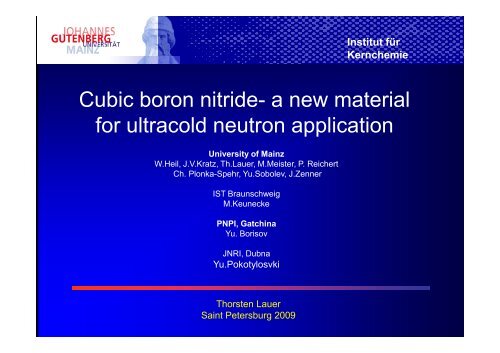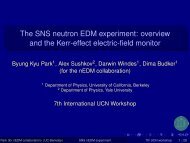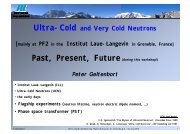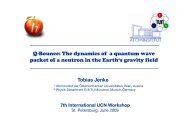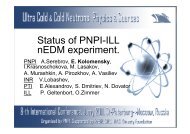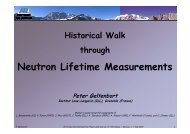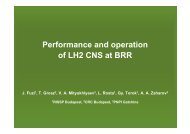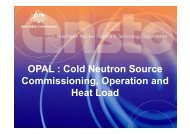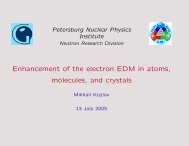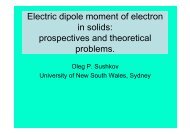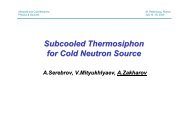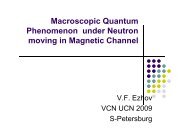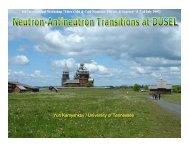Cubic boron nitride- a new material for ultracold neutron application
Cubic boron nitride- a new material for ultracold neutron application
Cubic boron nitride- a new material for ultracold neutron application
Create successful ePaper yourself
Turn your PDF publications into a flip-book with our unique Google optimized e-Paper software.
Institut für<br />
Kernchemie<br />
<strong>Cubic</strong> <strong>boron</strong> <strong>nitride</strong>- a <strong>new</strong> <strong>material</strong><br />
<strong>for</strong> <strong>ultracold</strong> <strong>neutron</strong> <strong>application</strong><br />
University of Mainz<br />
W.Heil, J.V.Kratz, Th.Lauer, M.Meister, P. Reichert<br />
Ch. Plonka-Spehr, Yu.Sobolev, J.Zenner<br />
IST Braunschweig<br />
M.Keunecke<br />
PNPI, Gatchina<br />
Yu. Borisov<br />
JNRI, Dubna<br />
Yu.Pokotylosvki<br />
Thorsten Lauer<br />
Saint Petersburg 2009
Institut für<br />
Kernchemie<br />
<strong>Cubic</strong> <strong>boron</strong> <strong>nitride</strong>- a <strong>new</strong> <strong>material</strong><br />
<strong>for</strong> <strong>ultracold</strong> <strong>neutron</strong> <strong>application</strong><br />
&<br />
Status of the UCN sources in Mainz<br />
University of Mainz<br />
W.Heil, J.V.Kratz, A.Kraft, Th.Lauer, Ch. Plonka-Spehr, Yu.Sobolev<br />
Thorsten Lauer<br />
Saint Petersburg 2009
Neutron optical potential<br />
V<br />
<br />
2<br />
<br />
2<br />
m<br />
<br />
i<br />
N i b i<br />
N: scattering center density<br />
b: bound coherent scattering length<br />
M: <strong>neutron</strong> mass<br />
Critical velocity:<br />
Common <strong>material</strong>s:<br />
V<br />
v c<br />
2<br />
m<br />
<strong>material</strong><br />
Fermi velocity<br />
potential<br />
[neV]<br />
[m/s]<br />
Be 252 6.9<br />
Ni 252 6.9<br />
stainless steel 200 6<br />
Al 54 3.3
Non common Materials<br />
<strong>material</strong><br />
Fermi<br />
potential<br />
[neV]<br />
velocity<br />
[m/s]<br />
Typical<br />
Application<br />
disadvantage<br />
58<br />
Ni 335 8 UCN guides Expensiv<br />
BeO 257 7.2 Storage vessel toxic<br />
Diamond 305 7.6 Storage vessel Production (H2)<br />
DLC 250 - 270 6.9 - 7.2 Storage vessel,<br />
guides<br />
Production (H2)<br />
Looking <strong>for</strong> <strong>new</strong> candidates with improved characteristics
Boron <strong>nitride</strong><br />
BN: molar mass: 24,83 g·mol −1<br />
scattering length: 14.66 fm<br />
insulator:<br />
>10 15 Ohm cm<br />
melting point: 2000°C<br />
Density: 3,45 g·cm −3 2,25 g·cm −3<br />
Fermipotential:<br />
338 neV 220neV
Film Production<br />
Coating per<strong>for</strong>med at IST Braunschweig (M.Keunecke)<br />
Reactive RF- sputtering in nitrogen<br />
Atmosphere from <strong>boron</strong> carbide target<br />
Infrared spectrum of typical samples<br />
Special procedure was developed by<br />
the IST to obtain 2µm layers of cBN<br />
- cBN peak at 1090 1/cm<br />
c-BN-Schicht ca. 0,2 µm<br />
RMS-Rauhigkeit 2,27 Å<br />
- hBN fraction from peak at 790 1/cm
First samples<br />
Natural <strong>boron</strong> (20% 10 B )<br />
V F<br />
338neV<br />
UCN death !!!<br />
767 barn absorption<br />
Isotopic enriched 11 B<br />
Coated with 300nm of cBN structur<br />
0.0055 barn absorption<br />
+ 2 barn of N 2<br />
Standard 3“ Silicon wafer<br />
nat. Ni 4.5 barn<br />
V F<br />
350neV
Neutron reflectometry<br />
Cold <strong>neutron</strong> (4.8 A) reflectometry per<strong>for</strong>med at HMI (Th.Krist)<br />
)<br />
waviness of sample<br />
Fit Result:<br />
not exact cut off angle<br />
300+/- 30neV
Transmission of UCN<br />
Time of flight method<br />
Foil holder<br />
Chopper<br />
Detector<br />
Cascade-U<br />
1000mm<br />
Neutrons<br />
Result of the fit<br />
305 +/- 15neV<br />
91% of theoretical density
Check of TOF methode<br />
Crosscheck:<br />
500nm Ni on Si wafer<br />
Fit Result :<br />
245 +/- 15neV<br />
98.2% of theoretical density<br />
Density verified by x-ray diffraction<br />
measurement !
First c 11 BN sample (96.22% 11 B)<br />
First <strong>boron</strong> 11 sample:<br />
- 340nm cBN on Si wafer<br />
- Stresses in layer !!<br />
- Production parameters are<br />
different from standard target<br />
- smaller absorption (100barn) !!<br />
- Preliminary Result of Fermi Potential<br />
~ 315 +/- 10neV<br />
~ 93% of theoretical density
Conclusion and Outlook<br />
- First measurement of the Fermi Potential of natural and isotopic enriched<br />
cubic <strong>boron</strong> <strong>nitride</strong><br />
- Further improvements of production parameters <strong>for</strong> isotopic <strong>boron</strong><br />
are needed<br />
- Investigation of losses during storage of <strong>ultracold</strong> <strong>neutron</strong>s in a vessel<br />
coated with highly enriched cubic <strong>boron</strong>-11 <strong>nitride</strong>
Conclusion and Outlook<br />
Investigation of B4C <strong>for</strong> non depolarizing UCN guides based on B 4 C<br />
Expected: 220neV Measured: ~ 211neV
Conclusion and Outlook<br />
Production of UCN guides based on discussed <strong>material</strong>s
Ultracold <strong>neutron</strong>s at the TRIGA Mainz<br />
Triga Mark II<br />
Pulse mode 250MW in peak<br />
constant power 100kW<br />
UCN C (tangential beamline)<br />
operation o since 2006)<br />
200000 UCN/2$ Puls<br />
Filling time 2.2 sec<br />
Helium consumption 16l/h<br />
Crystal Preparation 3 hours<br />
UCN D (Radial beamline)<br />
Source ready!<br />
Waiting <strong>for</strong> German TÜV approval
Munich/Mainz Prototype source<br />
D2 converter section<br />
≤ 7 mol of sD 2 or sH 2
Investigation of sD2<br />
1mol 2mol 3mol 5mol 6mol<br />
70<br />
60<br />
50<br />
Intensität [au]<br />
40<br />
30<br />
20<br />
10<br />
0<br />
0 2 4 6 8 10 12 14 16 18 20 22 24 26 28 30<br />
v(axial) [m/s]<br />
Mean free path of UCN inside sD2
Investigation of sD2<br />
crystal quality<br />
80<br />
80 70<br />
after after freezing freezing after<br />
after 1.cycling freezing after after cycling 2. cycling<br />
70<br />
60<br />
intensity[au<br />
u]<br />
60<br />
50<br />
50<br />
400<br />
40<br />
30<br />
Optimum not reached!<br />
3molsD<br />
2<br />
30<br />
20<br />
20<br />
10<br />
10<br />
0<br />
0 2 4 6 8 10 12 14 16 16 18 18 20 20 22 22 24 24 26 26 28 28 30<br />
30<br />
v(axial) [m/s]<br />
30min Cycling improves Frozen 2. Cycling deuterium transparency at 13Ksnowof<br />
deuterium
Investigation of sH2<br />
80<br />
3mol sD2 1.54mol sH2 0.14mol para hydrogen 2.81 mol para hydrogen<br />
70<br />
60<br />
50<br />
Intensity<br />
[au]<br />
40<br />
30<br />
20<br />
10<br />
0<br />
0 2 4 6 8 10 12 14 16 18 20 22 24 26 28 30<br />
v(axial) [m/s]<br />
First measured TOF spectras of a solid hydrogen UCN source
New beamline at radial channel<br />
sD2<br />
UCN guide<br />
sH2<br />
New Design of the converter section
New beamline at radial channel<br />
Blablabla !!
Thank you<br />
<strong>for</strong> your attention !


